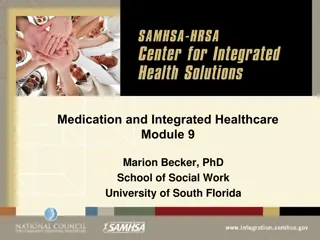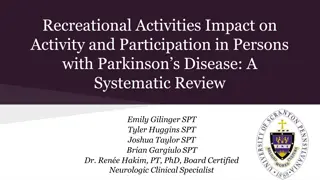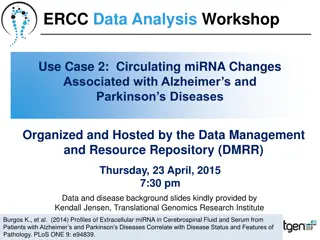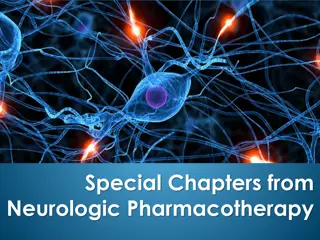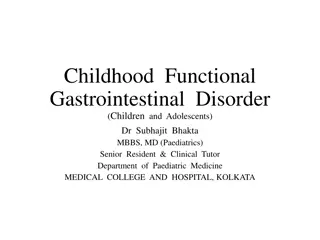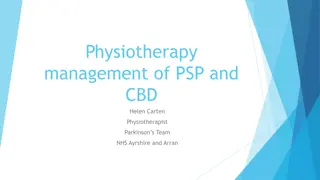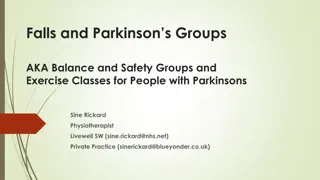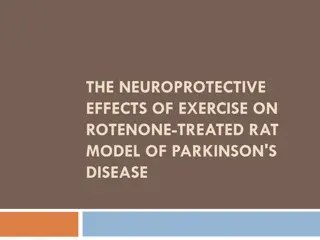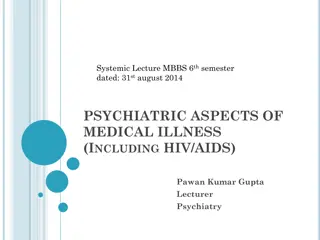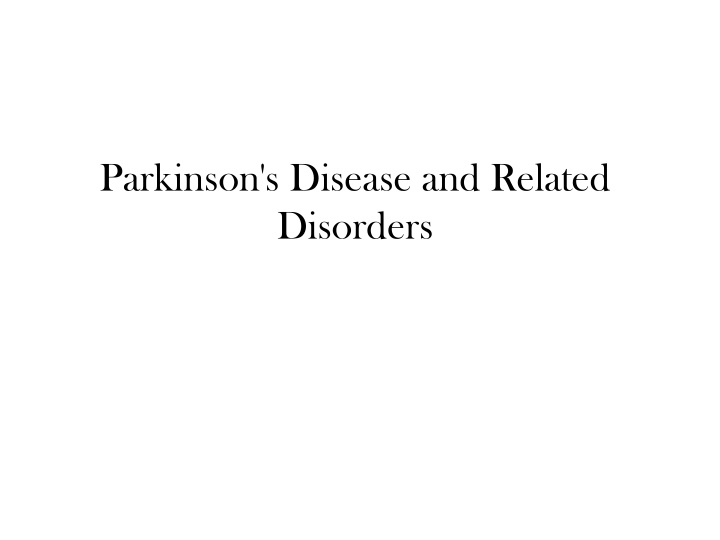
Parkinson's Disease and Related Disorders
Parkinson's disease (PD) is the second most common neurodegenerative disease, affecting millions globally. It primarily impacts dopaminergic neurons, leading to symptoms like tremors, bradykinesia, and facial bradykinesia. The disease has both sporadic and genetic etiologies, with environmental factors also playing a role.
Download Presentation

Please find below an Image/Link to download the presentation.
The content on the website is provided AS IS for your information and personal use only. It may not be sold, licensed, or shared on other websites without obtaining consent from the author. If you encounter any issues during the download, it is possible that the publisher has removed the file from their server.
You are allowed to download the files provided on this website for personal or commercial use, subject to the condition that they are used lawfully. All files are the property of their respective owners.
The content on the website is provided AS IS for your information and personal use only. It may not be sold, licensed, or shared on other websites without obtaining consent from the author.
E N D
Presentation Transcript
Parkinson's Disease and Related Disorders
Parkinson's disease (PD) 2ndcommonest neurodegenerative disease, affecting 5 million persons in the world. It affects men and women of all races, all occupations, and all countries. age of onset is about 60 years and the frequency increases with aging. The prevalence will dramatically increase in future decades.
Pathology the hallmarks of PD degeneration of dopaminergic neurons in the substantia nigra reduced striatal dopamine. intracytoplasmic inclusions ( Lewy bodies) .
Pathology neuronal degeneration with inclusion body formation can also affect cholinergic neurons of the nucleus basalis of Meynert (NBM), norepinephrine neurons of the locus coeruleus (LC), serotonin neurons in the raphe nuclei. neurons of the olfactory system, cerebral hemispheres, spinal cord, and peripheral autonomic nervous system. "nondopaminergic" pathology = nondopaminergic clinical features.
Etiology Sporadic (unknown cause) older patients (>50 years). 85 90%. environmental factors risk with exposure to pesticides, rural living, and drinking well water. risk with cigarette smoking and caffeine. genetic factors younger patients.
Tremor is the most common initial symptom (85% of patients). usually asymmetric, resting tremor and slow (3 5 Hz). It is typically distal with pronation supination tremor of the forearm or a pill rolling tremor of the finger. It may affect chin, lip, or tongue, but head and neck are rarely affected. As with other tremors, the amplitude increases with stress and resolves during sleep.
Bradykinesia (slowness of movement) Symptoms may include: subjective sense of weakness. loss of dexterity "message not getting to the limb . fatigability, when performing repeated actions.
Facial bradykinesia decreased blink rate and facial expression (masked face). monotonal Speech. Drooling (especially night time drooling).
Truncal bradykinesia slowness or difficulty in rising from a chair or turning in bed small steps gait with reduced arm swinging. Freezing, more prominent as patients attempt to navigate doorways or narrow areas and can result in patients getting trapped behind furniture.
In the upper extremities: small, effortful handwriting (micrographia) difficulty using the hand for fine activities (using a key). In the lower extremities: scuffing of foot on the ground(Shuffling gait),
Rigidity an increase in resistance to passive movement about a joint (hypertonia). smooth (lead pipe) or oscillating (cogwheeling). Postural instability imbalance and loss of righting reflexes. poorly amenable to treatment and a common source of disability in late disease.
nonmotor symptoms commonly precede motor signs substantial reduction in olfactory function (smell) rapid eye movement (REM) behavior disorder (RBD). loss of normal atonia during REM sleep. patients act out their dreams and may kick, hit, talk, or cry out in their sleep.
Diagnosis &Differential Diagnosis Diagnosis &Differential Diagnosis Parkinsonism = bradykinesia with rigidity and/or tremor. PD is the most common disease in parkinsonsm group (75% ). Old criteria: 2 of 3 (tremor, rigidity, bradykinesia) = 24% error rate. U.K. brain bank criteria parkinsonism associated with rest tremor, asymmetry, and a good response to levodopa= accurate in 99% of cases.
Parkinson's Disease Atypical Parkinsonisms Secondary Parkinsonism Other Neurodegenerative Disorders Wilson's disease Drug-induced Genetic Sporadic Dementia with Lewy bodies Multiple-system atrophy Cerebellar type (MSA-c) Parkinson type (MSA-p) Huntington's disease Tumor Neurodegeneration with Infection brain iron accumulation Vascular SCA 3 (spinocerebellar ataxia) Progressive supranuclear palsy Normal-pressure hydrocephalus Fragile X associated ataxia-tremor-parkinsonism Corticobasal ganglionic degeneration Trauma Prion disease Liver failure Dystonia-parkinsonism Frontotemporal dementia Toxins (e.g., carbon monoxide, manganese, MPTP, cyanide, hexane, methanol, carbon disulfide) (DYT3) Alzheimer's disease with parkinsonism
Magnetic Resonance Imaging (MRI) When clinical presentation does not allow a high degree of diagnostic certainty lack tremor acute or stepwise progression younger than 55 years. useful to exclude: Tumors multi-infarct state hydrocephalus Wilson disease. strokes
Levodopa (precursor of dopamine) administered in combination with a peripheral decarboxylase inhibitor (carbidopa or benserazide) most effective symptomatic treatment, almost all patients experience improvement. failure to respond should cause the diagnosis to be questioned
Acute dopaminergic side effects (nausea, vomiting, and orthostatic hypotension) avoided by: gradual titration. additional doses of a peripheral decarboxylase inhibitor (e.g., carbidopa) a peripheral dopamine-blocking agent such as domperidone.
Dopamine Agonists ergot derivatives: bromocriptine, pergolide & cabergoline (cardiac valvular damage) non-ergot dopamine agonists: pramipexole, ropinirole & rotigotine. have modest effect on parkinsonism. They are longer acting, so less prone to induce dyskinesia. For this reason, many physicians initiate therapy with a dopamine agonist. On the other hand, they can be used as adjuncts to levodopa to enhance motor function and reduce "off" time in fluctuating patients.
Acute side effects of dopamine agonists include: nausea, vomiting, and orthostatic hypotension. Hallucinations and cognitive impairment. Sedation with sudden unintended episodes of falling asleep. Impulse-control disorders: pathologic gambling, hypersexuality, and compulsive eating and shopping.
MAO-B Inhibitors Selegiline & rasagiline block central dopamine metabolism and increase synaptic concentrations of the neurotransmitter. provide modest antiparkinsonian benefits when used as monotherapy in early disease. reduced "off" time when used as an adjunct to levodopa in patients with motor fluctuations. has a disease-modifying effects, and significantly delayed the time until the emergence of disability, necessitating the introduction of levodopa in untreated PD patients.
COMT Inhibitors tolcapone & entacapone. When levodopa is administered with a decarboxylase inhibitor, it is primarily metabolized by catechol-O- methyltransferase (COMT). Inhibitors of COMT increase the elimination half-life of levodopa and enhance its brain availability. Combining levodopa with a COMT inhibitor reduces "off" time and prolongs "on" time in fluctuating patients.
Other Medical Therapies Anticholinergic Drugs trihexyphenidyl & benztropine. Their major clinical effect is on tremor. Their use is limited particularly in the elderly, due to their side effects (urinary dysfunction, glaucoma, and cognitive impairment). Amantadine in early disease it has mild symptomatic effects. widely used as an antidyskinesia agent in patients with advanced PD. Indeed, it is the only oral agent that reduce dyskinesia while improving parkinsonian features. Side effects include livido reticularis, weight gain, and impaired cognitive function.






